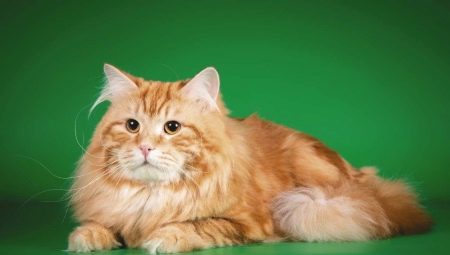These furry pets are one of the most magnificent breeds of the whole world. It seems that nature has combined all the best qualities in them, which is why red Siberian cats are considered a real miracle.
Brave and loyal, these cats have a natural hunting instinct and a strong, muscular structure. Squat large limbs, a large tail, beautiful eyes, a magnificent mustache and eyebrows, a furry collar and noble “pants” characteristic of this breed, reproduce in memory the image of Kotofey, familiar to us from childhood fairy tales. Today, representatives of this breed have become one of the symbols and treasures of our country.

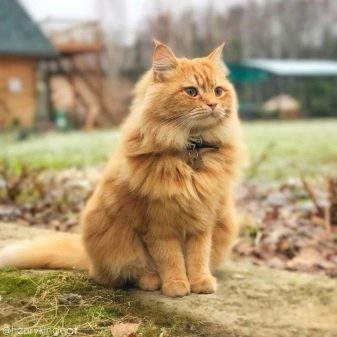
History of occurrence
There is an opinion that this type of cat has primordially Russian roots, but in fact this fact has a lot of rebuttals. Today we attribute Siberia to Russia, but if we turn to history, it will become clear that earlier Siberia was in the possession of the Tatars. Respectively, Asian cats living in the then Tatar forests - none other than the forefathers of the Siberians. Another likely option for the formation of the breed is the presence in their blood of the genome of wild cats living in the vast Trans-Urals.
Confirmation of this hypothesis is also facilitated by their similarity with wild relatives - behavioral traits, large sizes, weight.
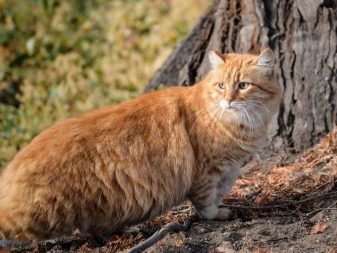

The breed was officially approved by domestic felinologists in 1987, almost at the first stages of the development of this science in Russia. Due to the danger of genetic variation, representatives of the breed did not initially take part in exhibitions.Only after some time, thanks to the work of breeders, the breed inherited the necessary traits, and in 1997 they began to admit it to international exhibitions.
Today, Siberian cat nurseries exist on the entire planet.
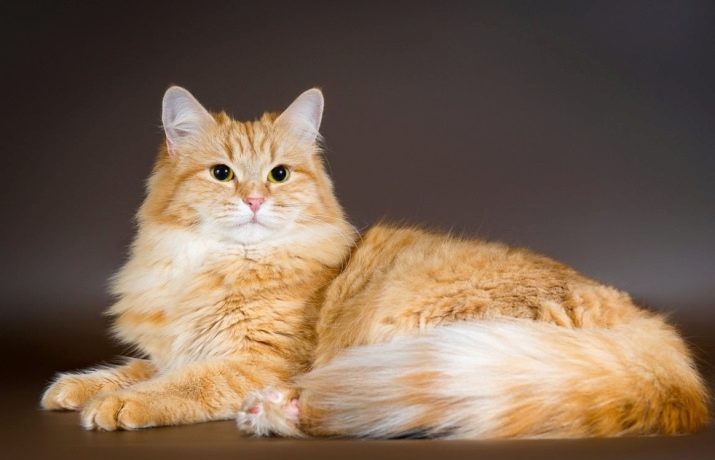
Breed description
Siberian red cats are the brightest representatives of the native Russian breeds. Strong immunity, independence, originality of behavior, stately nature - this makes them a real gift of nature. The British noticed that this animal deserves the reception of the Queen herself.
Preserving the natural appearance, hardening, temperament and good health of the wild forefathers, Siberian has an amazing appearance, amazing waterproof coat, has impressive dimensions. These cats will captivate with grace and power.
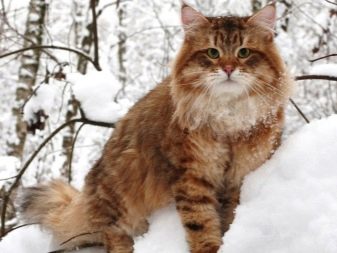
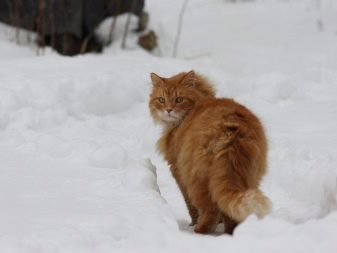
The paws of red Siberian cats have one distinctive feature - the presence of long tufts of wool near the paw pads, which remind us of the origin of these animals.
Siberian kittens are adorned with the previously mentioned “pants” on their hind legs and a fluffy shirt front. There is one more advantage: this breed can hardly provoke allergic reactions, which is very important for people who do not get cats because of fear of allergies.
A large, oval head, trapezoid expressive face, large cheeks, a convex forehead - the appearance of these cats is very famous and memorable. By nature, these cats are no less attractive, because poise and wisdom, combined with sensitivity and waywardness, create just an amazing temperament.
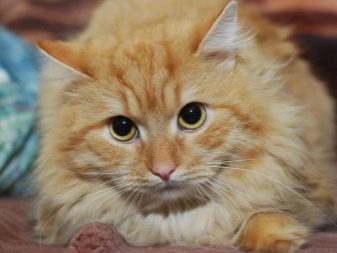
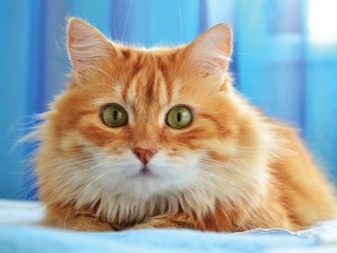
Thanks to the painstaking work of breeders, various stable colors of Siberians were created, many of which are artificial and practically do not appear in nature.
Various combinations of red with white, coffee and chocolate create an impressive appearance of these cats.
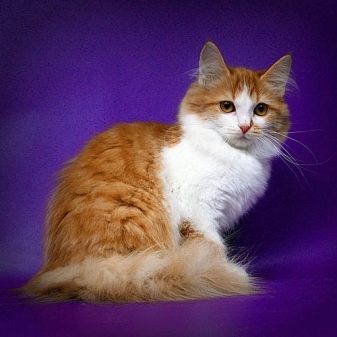
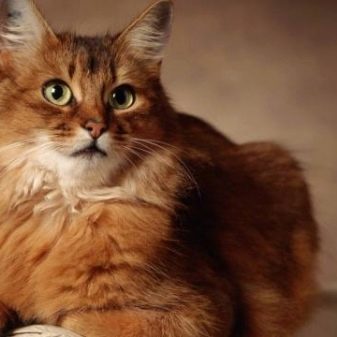
The standard for body weight is considered to be weight from 6 to 10 kg. Males of this breed are much larger than females. In height at the withers, cats (about 40 cm) also differ from cats (about 30 cm). Assessing the characteristics and standards of the breed, experts also take into account body weight and age characteristics of pets. The following is a list of generally accepted standards for red Siberian cats.
- Wool - two-layer: elongated spine and dense, short undercoat.
- Paws - large, round, short, providing high endurance of the animal and the ability to move around the snow cover. The hind legs should be longer than the front legs, and a long tuft of fur should be present between the pads.
- Eyes - oval, slightly slanting, widely spaced, medium sized.
- Neck - strong, shortened, strong.
- Head - smoothly defined, rounded, large, with a wide, slightly convex forehead.
- Tail - long, wide, tapering to an oval tip. The uniform, dense, falling edge of the tail allows us to consider it a real pride of Siberian cats.
- Torso - Muscular, with a strong skeleton, massive sternum. The overall physique resembles a rectangle.
- The ears - medium in size, widely spaced, with a slight forward tilt. At the rounded tips there are characteristic “tassels” with wild roots.
- Muzzle - Wide cheekbones and nose, slightly chin pushed back.
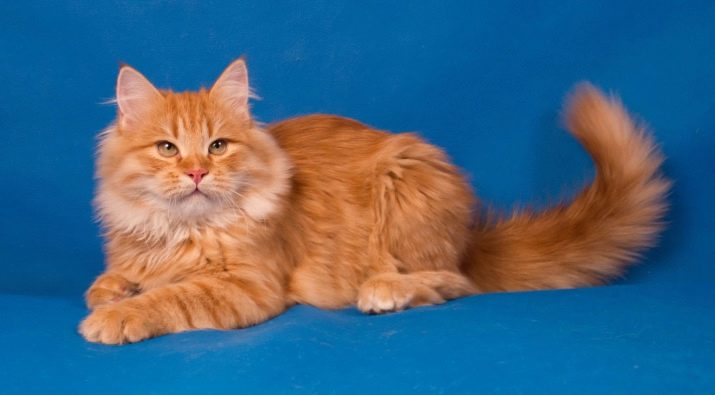
Nature and behavior
Siberian red cats, by their breed, are distinguished by unusual contact in communication, and their sociability characteristic for them allows them to cohabit in the same territory with other pets, including dogs. The nature of Siberian cats reflects sensitivity, grace and playfulness. Moderately sociable, these cats are completely independent and intelligent. They very well feel the fluctuations in the mood of their owners, showing the ability, if necessary, to both defend the owner and help him relax and relieve his stress. It is believed that red Siberian cats are able to heal from diseases.
As a rule, these cats take only one member of the family for the owner, and surround him with the maximum amount of attention and care. Despite the severe appearance, they are unusually patient, kind, trusting and balanced. These cats can become real friends for humans: they are ready to accompany you in household chores, despite their independence.
With great stamina, they will happily become your companion on long walks, regardless of the time of year.
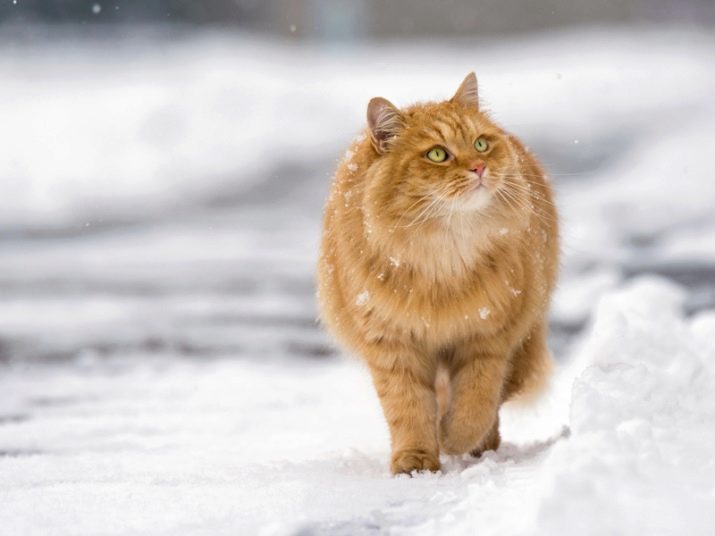
The lack of aggression and an unforgettable character is reinforced by wonderful watchdog skills. It is important to note one fact: there are exceptions when a cat's mood changes, and at the time of self-will, the cat loses patience. Understanding these features, do not pester a cat that does not want attention.
Another unusual fact for this breed is lack of fear of water.
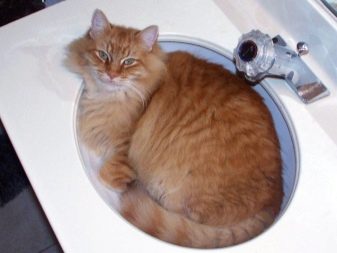
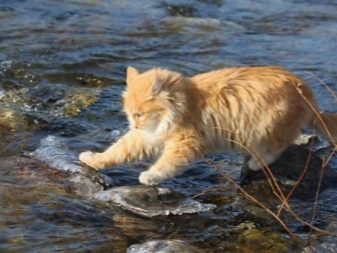
How to care?
Of course, the first point is to care for the luxurious hair of red Siberian cats. It is very important to teach cats to comb out from a young age - a used animal will be less resistant to procedures and tolerate it well.
Another nuance of Siberian wool care is its fading in the sun. This breed is very fond of warming the sides for a long time in the sun, but as a result of sunbathing, the wool can lose its natural color through burnout. Try to limit your cat’s exposure to the sun.
In addition, if your cat has tangles for some reason, use a special furminator comb that will cut shreds of hair when combing.
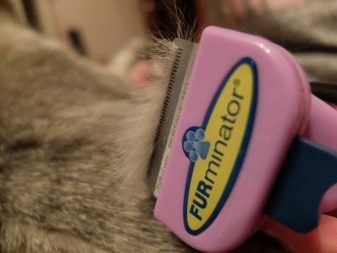

Although red Siberian cats are not afraid of water procedures, it is still worth bathing them only when necessary - before the show, after visiting the cottage or due to other pollution. It is necessary to bathe the cat carefully: try not to wet your head, but wipe it with a damp cloth. For daily or frequent hygiene procedures, special wet wipes for animals will be more appropriate, which you can walk on the wool and wipe the paws after a walk.
According to numerous reviews of owners and breeders, the best environment for keeping this breed of cats is summer cottages or country houses. Nevertheless, they get along pretty well in an apartment setting. It is worth considering the fact that it is very important for Siberians to have enough space for free movement, otherwise a bored pet will begin to gradually satisfy its boredom with your personal things or household items.
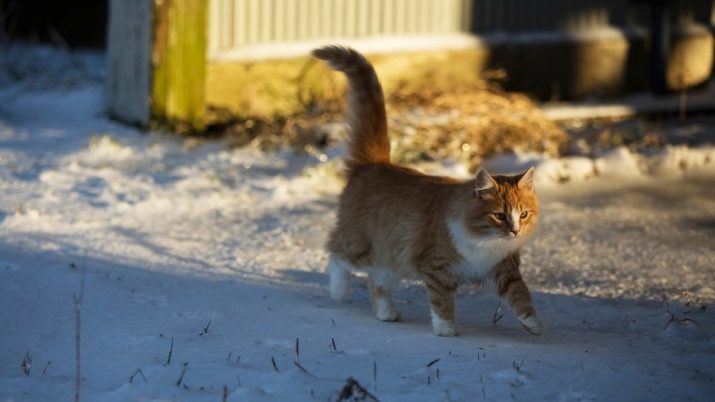
A routine examination of the auricles and eyes is a mandatory procedure for this breed. When sourness occurs, the eyes should be washed with warm water or 0.9% sodium chloride solution. Ears can be cleaned in the same ways, the main thing is that the solution does not flow into the auricle.
If the cat does not brush his teeth on time, he will have to carry out it in a veterinary clinic with the help of a dentist. The formation of tartar can provoke serious diseases that threaten the health of the cat.
Therefore, in order to prevent the occurrence of problems, it is worth buying a cat special toys and brushing your teeth at least once every 2-3 days.

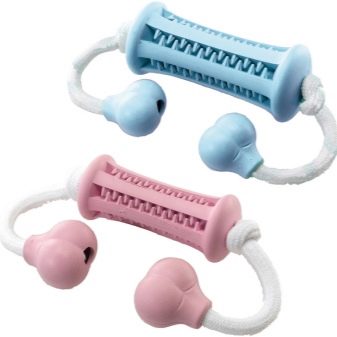
What to feed?
Regarding the diet, Siberian cats are unpretentious: vegetables and fruits may be present in its daily menu. Still, preference should be given to dry food: due to their solid structure, they prevent the appearance of tartar on the enamel of cat's teeth. A long-haired cat will not create you especially many problems in terms of nutrition.

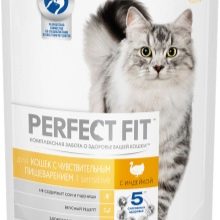
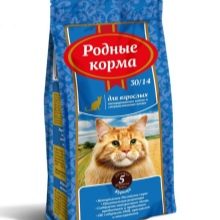
Health
Unfortunately, this breed of cats, although it has strong hereditary immunity, but also has some natural tendencies to diseases caused by genetic breeding of the breed. The most common diseases of red Siberian cats are localized in the kidneys, genitourinary system, gums. And also this breed has tendency to cancer.
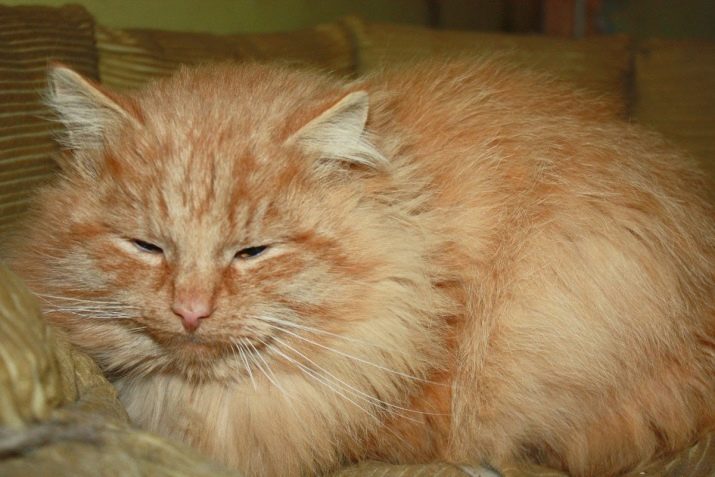
Periodontal disease is the most common disease for this breed. It is characterized by untimely removal of tartar, as a result of which an infection is formed in the jaws of the animal, destroying the gums and teeth. Unfortunately, advanced periodontal disease is treated in only one way - by removing the affected teeth. The provocateur of the disease is malnutrition and insufficient dental care.
Polycystic kidney disease is common in cats after 8 years. With a disease, the kidneys increase in size or cease to function. The disease develops slowly, but most often it is almost asymptomatic, which does not allow to diagnose it in time and start treatment. Of the main symptoms noted: weight loss, loss of appetite, thirst, frequent urination.
Diseases of the genitourinary system are most often expressed by the formation of crystal stones, which interfere with the normal passage of urine. As a result of untimely detection, infection in the body is possible. The main signs are the appearance of blood impurities in the urine, frequent urge to urinate, “marks” by the tray, refusal to eat, pain in the abdomen.
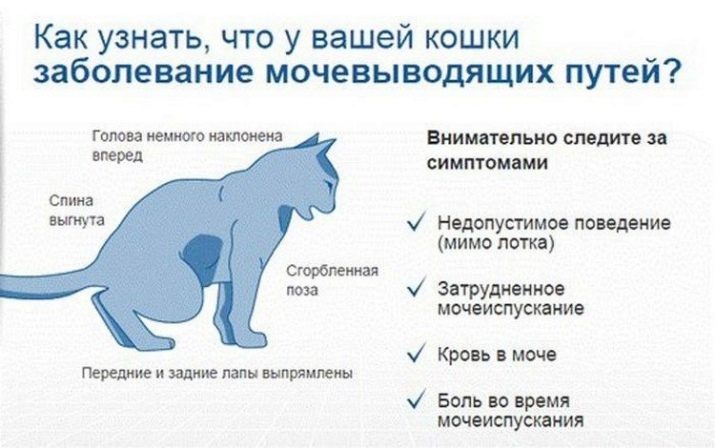
Life span
Considering the issue of the life expectancy of Siberians, it is worth noting that it directly depends on the specifics of the content. If the rules of care are followed carefully, the cat will live about 20 years, while maintaining an active and inquisitive character. The average lifespan of this breed is from 16 to 18 years. In comparison, other cats live up to 14 years. According to the latest data, the average life expectancy of Siberian cats has increased to 18-20 years.
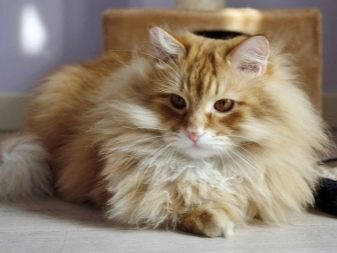
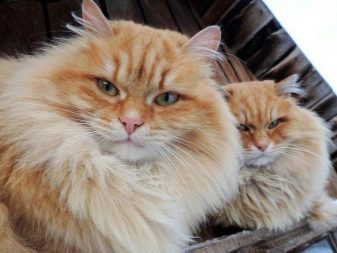
About what the owner needs to know about Siberian cats, see the next video.
